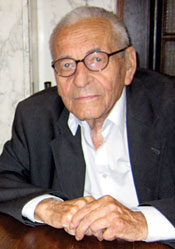Nicolaas Godfried van Kampen
DOI: 10.1063/PT.3.2320
Nicolaas Godfried van Kampen, a theoretical physicist who was instrumental in the development of modern statistical mechanics and scattering theory, died in Nieuwegein, the Netherlands, on 6 October 2013. He was an emeritus professor of theoretical physics at the University of Utrecht. For many years he served as the conscience of theoretical physics in the Netherlands and throughout the world.

Nicolaas Godfried van Kampen

Nico was born into an intellectual family in Leiden on 22 June 1921. His mother’s brother, Frits Zernike, was a professor of physics in Groningen and received the Nobel Prize in Physics in 1953. Nico’s nephew Gerard ’t Hooft shared the 1999 Physics Nobel.
In 1939 Nico studied physics and mathematics at the University of Leiden. A year later the Germans occupied the Netherlands, and the university was closed soon after. Although he wasn’t Jewish, Nico was the right age to be shipped to Germany as forced labor, so he learned to be evasive and disappeared periodically. During the Nazi occupation, his family hid at least one refugee.
Nico moved to Groningen to continue his studies under Zernike. He obtained his diploma in 1947 and returned to Leiden the next year to work on his doctorate under Hendrik Kramers, whom he greatly admired. He received his doctorate in January 1952. In his thesis, on the quantum theory of light scattering, he discussed the interaction of an electron with the electromagnetic field and incorporated some of Kramers’s work on renormalization.
After spending the next year at the Institute for Advanced Study in Princeton, New Jersey, Nico returned to Leiden. In 1955 he became a lector at Utrecht and in 1958, a professor. Over the years he was a visiting professor at Columbia and Harvard Universities, MIT, and other institutions.
Nico’s research covered such a broad range of topics in physics and philosophy that it is difficult to summarize all his contributions. His publications frequently dealt with fundamental concepts that have become significant in the history of physics. His first papers expanded on his thesis work and on the analytic properties of the S- and R-matrices. His research on the S-matrix provided a foundation for a myriad of publications on scattering.
Soon Nico turned his attention to statistical mechanics. In 1955 he studied the dispersion equation for plasma waves, in which he discovered what are now known as the van Kampen modes. In 1961 he developed a powerful new technique for obtaining cluster expansions for a classical gas. With Ubbo Felderhof, Nico wrote Theoretical Methods in Plasma Physics (North-Holland, 1967).
Additionally, in 1968 Nico clarified the field of relativistic thermodynamics, which greatly needed it. He studied the one-dimensional van der Waals gas in 1970 and obtained insight into the properties of systems with infinite range potentials.
One of Nico’s most important contributions is his 1981 book Stochastic Processes in Physics and Chemistry (North-Holland), from which vast numbers of students have learned the topic. His work on stochastic differential equations, which started in 1975, also had vast applications and led to interesting research on nonlinear irreversible processes. Another important contribution was his 1985 paper on elimination of fast variables, which provided an extremely simple technique for deriving Langevin and Master equations and their generalizations. Although Nico’s views on quantum chaos were controversial at first, they are now widely shared. The same is true for his 1988 ideas about quantum measurements.
Nico waged battles in print and in seminars with the practitioners of what he called waanwetenschap, or pseudoscience. That sometimes earned him the title Pietje Precies, which meant he was overly precise in his scientific view and that something valuable was lost in the process. I strongly disagree with the epithet and with the thought behind it.
Physics probably was Nico’s true love. He never married and lived a fairly abstemious life. He was widely read—the weight of his library sank the foundations of the converted farmhouse that he loved and lived in for many years—and he had a warm and interesting personality.
He and I made many trips together. Before I married, we traveled to Hammerfest, Norway, to experience the midnight sun and to Afghanistan, where we saw extraordinary things, including its large Buddhas. After I got married we traveled en famille—my wife, Bernice, and our son, Josh, enjoyed Nico’s company. On a trip to Sicily, Nico demonstrated his map-reading ability by getting us lost for hours along a road that ended in deserted countryside.
Nico’s students characterized him as an honored teacher. After his death, one of his Canadian nephews wrote to me and gave this beautiful description: “We do miss Nico’s mordant wit as well as his kindness and loyalty. When we were children my brothers and I thought that his mixture of ironic humour and high intelligence was typical of all Dutchmen. Only later did we learn how singular he was.”
More about the Authors
Irwin Oppenheim. Massachusetts Institute of Technology, Cambridge.
